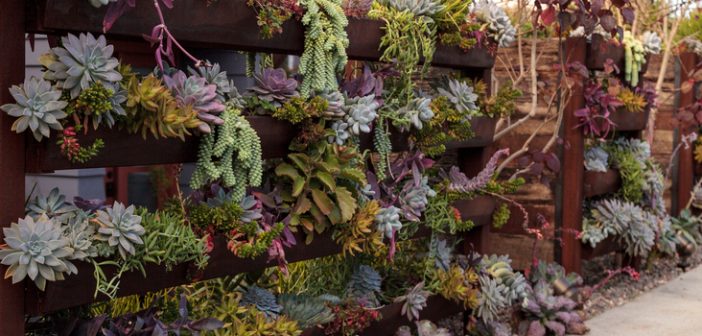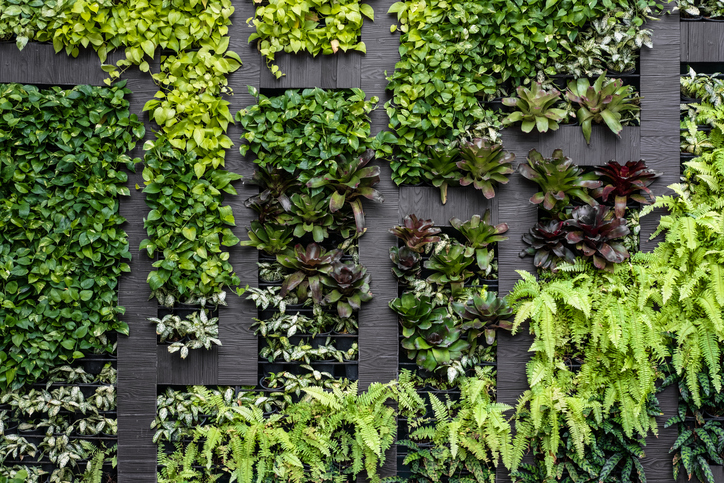On holidays, we have a little more time to spend on the home. Also, it’s time to give the terrace some style so we can enjoy the nice weather. The perfect time to create that vertical garden we’ve had in mind for so long!
Vertical gardens are becoming ever more common in different types of spaces, such as private courtyards, museums, public squares or historic buildings. New solutions are being used to decorate walls that were not previously suitable for natural elements, and bring a freshness and a more pleasant appearance wherever they are used.
Many of us have certainly thought about how they might be possible. Where to put them? How to water them? What species to use? Here we’ll discuss different issues that arise when designing a vertical garden.
Key factors
First of all, we must be aware of the natural capacity of the plants being used so that they survive hanging and interconnected. The plants used should, therefore, be a type that adapts easily to the surroundings, and easy to find. The plants must be carefully selected because these ecosystems require the interaction of all the plants, bacteria and fungi in a way that’s beneficial to all of them.
Regarding the construction of the structure to accommodate them, make sure the plants have a support that offers them the right conditions for their survival and a correct nutrition input. This will ensure that they can develop in that position so they will look even better than those on the ground.
Other factors to take into account when selecting your components:
- When choosing the plants, be careful of aspects such as the nutrients they’ll need, the bacteria they have or the inter-specific symbiosis of the different species and their interrelationship.
- The necessary substrate is very important, as are the environmental conditions and the physical and chemical characteristics of the environment where the garden will be hung. Mainly whether it will be indoor or outdoor, while also taking into account factors such as light, temperature and humidity.
- It will be essential to control any imbalances that may occur. These might include pH, water conductivity, salinity, texture or the porosity of the substrate. These factors can be monitored by sensors that alert you to any imbalances as soon as they arise.
- For their sustenance, systems based on panels, geogrids, or in superimposed flowerpots can be used to create vertical gardens. Their final appearance is somewhat artificial, so to get a natural look, other solutions will have to be found.
Creating your vertical garden
- Design and distribution
Think first of all about the design, the way you want your vertical garden to look. Do you prefer only green tones or several shades of colour? Do you want a flatter surface or plants that protrude a lot?
Once you have chosen the components, organise their distribution. For their placement, both bespoke and more highly sophisticated options are also available on the market, but you can also find prefabricated systems that will make the support of the plants more comfortable.
- The substrate
Next, let us discuss the substratum. There are a variety of options when it comes to creating small domestic gardens (hydroponic, with soil, mixed and so on), once you have learned about their advantages and drawbacks and have chosen the one that best suits your needs, add it in.
- Irrigation
After placing the support and substrate in the place chosen for the vertical garden, you can start with the installation of the irrigation system. The complexity or simplicity of the system depends on the type of substrate you have chosen. If, for example, you opt for a modular system with soil, you only need a drip irrigation system. To make sure you have made the right choice, you should seek the advice of a professional.
- The plants
Once the structure is assembled, and the watering system is running correctly, it’s time to place the plants. Remember that in choosing a spot for the plants, bear in mind the aforementioned environmental factors. Follow the design you have planned and each plant in its assigned place. They should receive adequate levels of light and humidity.
There you have it: your garden is ready and safe, and your terrace or patio is perfect. All that’s left now is to welcome the guests for that special holiday evening!








